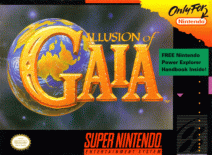
































Illusion of Gaia

Illusion of Gaia, known in Europe and Australia as Illusion of Time, is an action role-playing game that was released for the Super Nintendo Entertainment System on November 27, 1993.
Illusion of Gaia is set in a partially historical but mostly fantasy-based version of Earth. The game contains several real-world sites, such as Incan ruins, the Nazca Lines, Angkor Wat, the Great Wall of China and the Egyptian pyramids. Each of these ruins hold a piece to the final puzzle, unveiled at the top of the infamous Tower of Babel.
It is firstly believed to be the age of exploration (a period roughly corresponding to the 16th century; Christopher Columbus is mentioned at least once), and explorers have begun scouring the world in search of ancient ruins and the lost treasures and secrets within. Many return with nothing, and some are simply never seen again. Will, the protagonist of the game, is a survivor of one such ill-fated expedition. He accompanied his father, a famed explorer, on a sea journey to uncover the secrets of the Tower of Babel, but the explorers met with a mysterious disaster. Somehow Will managed to make it back to his hometown, but he does not remember how.
While Illusion of Gaia has a large cast of characters, Will, Freedan and Shadow are the only playable characters in the game. They each have unique abilities, and certain areas are impassable without a specific character. The characters gain techniques as part of the story. Will's techniques are all based on reaching new areas with incidental combat applications, while Freedan's techniques are more combat-oriented. Shadow arrives late in the game, but being such a powerful character, he causes Freedan to be nearly obsolete.
Combat is relatively simple. Characters share the same health and defense scores, but have different levels of strength. Freedan, for example, does noticeably more damage, and has a longer reach than Will. In turn, Shadow does more damage than Freedan. Attacks are almost exclusively melee, using Will's flute, Freedan's sword or Shadow's pseudopod. Enemies' health bars appear upon attacking, displaying as a series of red spheres that represent hit points. Bosses cannot be revisited, and enemies do not reappear unless Will loses all his lives or completely exits an area and then returns.
Illusion of Gaia has a general design that is uniquely simple as RPGs go. The game eschews the experience system of typical role-playing video games; instead, the game has a more novel system for advancing the player character's statistics. Defeating all enemies in a room earns the player a permanent stat bonus in the form of a jewel. These jewels boost attack, defense or health power. While returning to a cleared area will cause enemies to reappear, the bonuses for defeating them again do not. Also, after an enemy is killed, it will leave a stone — either a small or a great one. Collecting 100 of these allows you to restart closer to where you died with all enemies still defeated, by earning a new life.
Also, the game has no currency or equipment systems. There is only one healing item (herbs), and only a small number of those in the game. Unlike most games of its type, formerly visited areas become impossible to revisit almost immediately after the story progresses beyond them until the last third of the game, though areas from the first two-thirds of the game remain inaccessible. The only sidequest in the game, finding Red Jewels, thus becomes impossible to complete if the player fails to find them before advancing the story.
Like most RPGs, the game has only one difficulty setting. Saving is accomplished at Dark Spaces located throughout each level — including areas without enemies, such as Will's hometown. Will can recover lost health within the Dark Spaces, and occasionally switch forms or gain new abilities.
How to play:
Click on the joystick icon in the Illusion of Gaia online emulator to see how to control the Illusion of Gaia game









































Comments